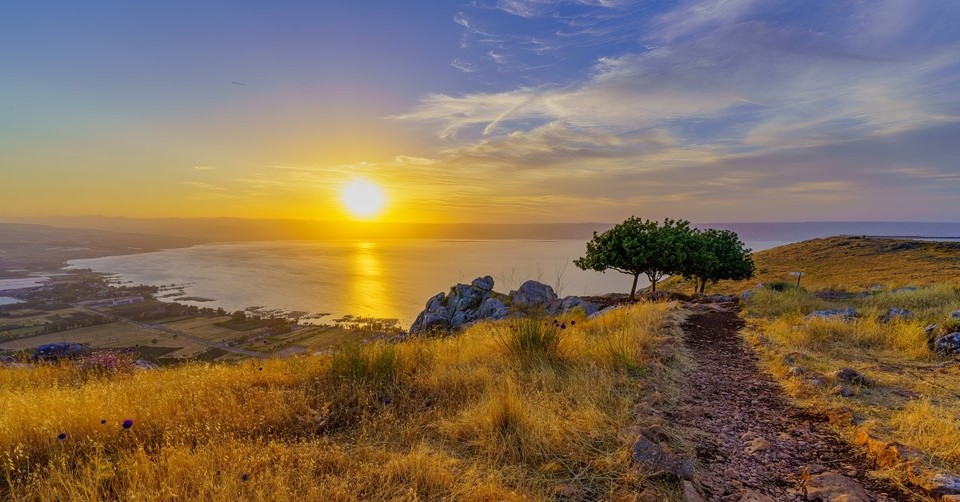Why Were People Shocked that Jesus Came From Galilee?

Galilee is rarely featured as a prominent setting for any major stories or events outside the gospels. In fact, to most Jews living in Jerusalem and Judea, there was a general disregard and even disdain for Galilee and its residents. So how did this remote, obscure region to the north of Jerusalem become one of history’s most important settings? There is one reason.
In Galilee’s fertile valleys, vineyards, olive groves, wheat fields, villages, and the lake that shares its name, Jesus Christ spent His formative years growing “in wisdom and stature, and in favor with God and men” (Luke 2:52). Here, Jesus would begin His public ministry, performing some of His greatest miracles and delivering some of His most popular teachings. In fact, most of Jesus’ three-year earthly ministry was spent in and around Galilean villages and the shores of its now-famous sea. Let us, therefore, take a journey to Galilee, a key setting in the life and ministry of Jesus Christ.
What Was Galilee in Ancient Israel?
Geographically, Galilee is located at the northernmost edge of Israel. In the Old Testament, the region became known as Galilee as early as the seventh century B.C., when land was allocated to the tribes of Naphtali, Asher, Issachar, and Zebulun following the conquest of Canaan (Joshua 19).
The kingdom of Israel was divided into the northern and southern kingdoms during the reign of Rehoboam, the son of Solomon. When that happened, Galilee became the northern kingdom’s northernmost border. Galilee was likely the first to be attacked and overcome by the Assyrian Empire when they invaded Israel in 722 B.C.
With the fall of Israel at the hands of Assyria, some surviving Jews might have remained in Galilee; others would have returned with the various groups of exiles when they came back to Israel from Babylon and Persia beginning in 538 B.C.
In the intertestamental period, Galilee would become a hub of commerce and trade for both the Greek and Roman Empires. In 47 B.C., Herod Antipater was appointed by Julius Caesar to act as a puppet governor over the various regions of Israel. As descendants of Esau, the Herodians would have been seen and treated as outsiders to the Jews. Needless to say, the Jews living in Galilee and Judea had little love for the Herodians, whom they saw as a threat to their national sovereignty.
At the time of the New Testament, Israel was separated into three districts: Judea, Samaria, and Galilee, with Galilee being the largest. The Jezreel Valley and Samaria were located directly south of Galilee, Phoenicia and the Mediterranean Sea were to the west, and the Decapolis and tetrarchy of Herod Philip were situated to the east.
Separated into Upper and Lower Galilee, Galilee was a beautiful, fertile region that received ample rainfall and supported the growth of olive trees, vineyards, and other agricultural products.
Upper Galilee, with its high plateaus and dense forests, was more isolated from the rest of the region and, therefore, not featured in many stories of the Bible. Lower Galilee, by contrast, was blanketed with rolling hills, a favorable climate, and rich and fruitful soil. Small farms, rural villages, and simple towns like Nazareth, Cana, Capernaum, and Bethsaida dotted the landscape in the New Testament era.
Of course, Bible students will also be familiar with the large freshwater lake that hosted Jesus and His disciples on more than one occasion. Thirteen miles long and seven miles wide, the Sea of Galilee is also referred to as the Sea of Tiberias (John 6:1), Sea of Chinnereth (Deuteronomy 3:17), Lake Gennesaret (Luke 5:1), or simply “the lake” (Luke 5:2), supported a bustling fishing industry. This is the trade that many of Jesus’ disciples found themselves in before meeting Jesus.
It is also worth noting that in the first century, a branch of the International Coastal Highway ran along the northwest shore of the Sea of Galilee, passing near or through Galilean towns like Capernaum, Magdala, and Bethsaida. Due to commercial trade, Galilee had a much larger Gentile presence and influence than the southern regions of Israel. For this reason, the Jews of Galilee were known to have frequent interactions with Phoenicians, Syrians, Sidonians, Greeks, and Romans, who resided in and around Galilee. Sepphoris, for example, the capital of Galilee, was often referred to as “Galilee of the Gentiles” because it had more non-Jewish residents than Jewish residents.
This caused the Judeans to see the Galileans as backward, working class, uncultured nobodies, too liberal and relaxed in their dealings with the Gentiles. Because of the Greek and Roman influence over Galilee, the Judeans say the Galileans’ religious piety as corrupted. Furthermore, the Galileans’ dialect and accents were considered ugly and less refined than the rest of Israel (Matthew 26:69-74).
The Roman army also had to watch Galilee, as the northern regions had proven to be a hotbed, training ground, and staging point for the Zealots fighting their war against Rome.
In any case, this is the historical context of the world in which Christ was born. However, although Galilee is the major backdrop for the gospels, particularly as it relates to Jesus's childhood, adult life, and ministry, the region is rarely mentioned in other passages in the Bible.
What Town in Galilee Did Jesus Come From?
Shortly after Jesus was born in the town of Bethlehem (in Judea), Matthew’s gospel tells us that Joseph was warned in a dream to take his wife and newborn son and flee to Egypt. This was done to protect Jesus from Herod the Great, the regional governor, who was searching for the prophesied Messiah so that he might destroy him and prevent a legitimate Jewish heir from reclaiming the throne of David. Enraged when he could not locate the promised Child, Herod famously slaughtered all the male children two years old and under who were in Bethlehem and the nearby region at the time (Matthew 2:16).
Thankfully, Herod’s attempt to destroy the Messiah ultimately failed, as the Holy Spirit led Mary and Joseph to escape Judea. For nearly two years, Mary, Joseph, and Jesus sojourned in Egypt away from the reach of Herod the Great. When Herod died, however, an angel of the Lord appeared again to Joseph in a dream, telling him, “Get up, take the Child and His mother, and go into the land of Israel; for those who sought the Child’s life are dead” (Matthew 2:20).
After Herod’s death, the region he governed was divided amongst his sons.
- Antipas was put in charge of Galilee and Perea.
- Philip II was made the tetrarch over the regions north of Galilee.
- Archelaus (Matthew 2:22) was given control over Judea, Samaria, and Idumea.
We know from history that Archelaus was renowned for his cruelty and authoritarian approach to governing. For this reason, Joseph may have wanted to bypass Judea and settle his family in Galilee beyond Archelaus’ jurisdiction. As it is written, “Then after being warned by God in a dream, he (Joseph) left for the regions of Galilee, and came and settled in a village called Nazareth. This happened so that what was spoken through the prophets would be fulfilled: “He will be called a Nazarene.” (Matthew 2:22-23)
In Nazareth, Jesus would spend His formative years until He was ready to begin His public ministry at the age of thirty (Luke 4:16). When He did, many referred to Him as “Jesus of Nazareth” (Acts 10:38) or “Jesus the Nazarene” (Mark 1:24; Luke 24:19), perhaps to distinguish Him from other rabbis or public figures with the same name.
How Much Ministry Did Jesus Do in Galilee?
Shortly after Jesus completed His temptation in the wilderness, He began teaching in the synagogues of Galilee (Luke 4:14-15). Here, He began His public ministry. Accordingly, most of Jesus’ three-year ministry was spent ministering in the towns and villages throughout Galilee (Matthew 4:13).
His popularity grew as news of Jesus’ teaching and miracles spread throughout Galilee and beyond. However, many Jews were surprised to learn of Jesus’ humble upbringing. Many in Galilee would follow Jesus; many more would abandon Him over time. This was to fulfill what was written of the Messiah, that He would be despised, scorned, and abandoned by even His own hometown and neighbors (Psalms 22; Isaiah 53; Matthew 13:57).
Nevertheless, much of Jesus’ earthly ministry was spent in and around Galilee. Here are a few of the notable things that happened during His Galilean ministry:
- Jesus gathers His first disciples (John 1:43-51; Matthew 4:18-25)
- Jesus turns water into wine at a wedding in Cana (John 2:1-12)
- Jesus heals Peter’s mother-in-law in Capernaum (Mark 1:29-34)
- Jesus heals a man with leprosy (Luke 5:12-16)
- Jesus raises a widow’s son from the dead at Nain (Luke 7:11-17)
- Jesus teaches in parables on the Sea of Galilee (Matthew 13:1-34)
- Jesus casts demons out of a man and into the pigs (Mark 5:1-20)
- Jesus raises Jairus’ daughter and heals the bleeding woman (Mark 5:21-43)
- Jesus delivers His Sermon on the Mount (Matthew 5:1-7:29)
- Jesus calms a storm on the Sea of Galilee (Luke 8:22-25)
- Jesus feeds the 5,000 (Luke 9:10-17)
- Jesus walks on water on the Sea of Galilee (Matthew 14:22-36)
- Jesus is transfigured and seen by Peter, James, and John in His glory (Mark 9:2-13)
- Jesus teaches about the kingdom of God in Capernaum (Matthew 17:24-18:35)
Of course, Jesus did many more things in Galilee and beyond. These were just a few of the signature miracles and teachings that marked His Galilean ministry.
What Can We Learn from Jesus’ Ministry in Galilee?
Throughout Jesus’ earthly ministry, many people in Galilee and beyond marveled at all that Jesus said and did (Matthew 7:28, 9:8, 12:23, 22:33; Mark 2:12, 11:18; Luke 13:17, 23:48). However, the fact that this man, who many knew to be the Messiah, had come from a place as obscure and unremarkable as Galilee was astonishing. It is also remarkable that Jesus chose to spend so much time ministering to Galilee’s rural villages and communities than the more metropolitan centers of Israel, such as Jerusalem. Yes, Jesus would eventually move His ministry to Jerusalem. But in many, His ministry to the Jews and non-Jews of Galilee reflected His humble, servant-like attitude.
At one point, Jesus would return to His hometown to teach in the synagogue, at which time His neighbors and those who had watched Him grow up asked themselves, “Where did this man acquire this wisdom and these miraculous powers? Is this not the carpenter’s son? Is His mother not called Mary, and His brothers, James, Joseph, Simon, and Judas? And His sisters, are they not all with us? Where then did this man acquire all these things?” (Matthew 13:54-57)
In many ways, that was the sentiment of many in Judea regarding Galilee, a backwater region with little to offer the world. Nevertheless, God chose this region as the childhood home for His one and only Son (John 3:16). He also set Galilee as the stage for some of Christ’s earliest and greatest work. Like His humble beginnings and the men Jesus called to be His disciples, Galilee is today a reminder that God often “uses the foolish things of the world to confound the wise” (1 Corinthians 1:27).
Before Jesus, Galilee had little claim to fame. After Jesus’s death, burial, and resurrection, however, the world would forever remember Galilee and celebrate this rural landscape for giving it its greatest treasure in the Son of God, the Vine, the Bread of Life, and the Light of the World.
Photo Credit:©Getty Images/RnDmS

This article is part of our larger resource library of Christian questions important to the Christian faith. From core beliefs to what the Bible says about angels, we want to provide easy to read and understand articles that answer your questions about Christian living.
What Do Christians Believe?
Is Gambling a Sin?
Is Drinking Alcohol a Sin?
What Does God Look Like?
Are Guardian Angels Real?
What is Heaven Like?
Originally published May 13, 2024.







